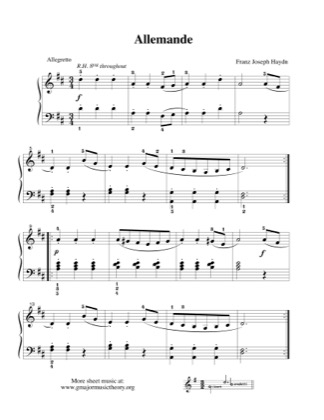All Creatures of Our God and King
Andrew Hawryluk1,554

This is free piano sheet music for Allemande, Haydn provided by gmajormusictheory.org
An allemande (also spelled allemanda, almain(e), or alman(d)) (from the French word for "German") is one of the most popular instrumental dance forms in Baroque music, and a standard element of a suite. Originally, the allemande formed the first movement of the suite, before the courante, but, later, it was often preceded by an introductory movement, such as a prelude.The allemande originated in the 16th century (Renaissance) as a duple metre dance of moderate tempo, derived from dances supposed to be favoured in Germany at the time. No German dance instructions from this era survive, but 16th century French (Arbeau) and British (Inns of Court) dance manuals for the Almain do survive. In general the dancers formed a line of couples, extended their paired hands forward, and paraded back and forth the length of the room, walking three steps, then balancing on one foot; a livelier version, the allemande courante, used three springing steps and a hop.French composers of the 17th century experimented with the allemande, shifting to quadruple meter and ranging more widely in tempo. The form of the allemande was used for the tombeau. Other identifying features include an upbeat of one or occasionally three sixteenth notes, the absence of syncopation, its combination of short motivic scraps into larger units, and its tonal and motivic contrasts. German composers like Froberger and Bach followed suit in their allemandes for keyboard instruments, although ensemble allemandes tended to stay in a more traditional form. Italian and English composers were more free with the allemande, writing in counterpoint and using a variety of tempi (Corelli wrote allemandes ranging from largo to presto).The allemande was traditionally regarded as a rather serious dance; in his Musikalisches Lexicon (Leipzig, 1732), Johann Gottfried Walther wrote that the allemande "must be composed and likewise danced in a grave and ceremonious manner." Likewise, in Der Vollkommene Capellmeister (Hamburg, 1739), Johann Mattheson described the allemande as "a serious and well-composed harmoniousness in arpeggiated style, expressing satisfaction or amusement, and delighting in order and calm" Late in the 18th century, "allemande" came to be used for a new type of dance in triple meter; Weber's Douze allemandes op. 4 of 1801 anticipate the waltz. Additionally some of the close embraces and turns of the original Allemande were carried over to Square Dance and Contra Dance, with the moves "Allemande left" and "Allemande right", (often spelled "Alamand") in which couples hold one arm and turn around each other.
